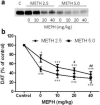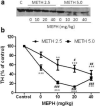Mephedrone does not damage dopamine nerve endings of the striatum, but enhances the neurotoxicity of methamphetamine, amphetamine, and MDMA
- PMID: 23205838
- PMCID: PMC3604033
- DOI: 10.1111/jnc.12114
Mephedrone does not damage dopamine nerve endings of the striatum, but enhances the neurotoxicity of methamphetamine, amphetamine, and MDMA
Abstract
Mephedrone (4-methylmethcathinone) is a β-ketoamphetamine stimulant drug of abuse with close structural and mechanistic similarities to methamphetamine. One of the most powerful actions associated with mephedrone is the ability to stimulate dopamine (DA) release and block its re-uptake through its interaction with the dopamine transporter (DAT). Although mephedrone does not cause toxicity to DA nerve endings, its ability to serve as a DAT blocker could provide protection against methamphetamine-induced neurotoxicity like other DAT inhibitors. To test this possibility, mice were treated with mephedrone (10, 20, or 40 mg/kg) prior to each injection of a neurotoxic regimen of methamphetamine (four injections of 2.5 or 5.0 mg/kg at 2 h intervals). The integrity of DA nerve endings of the striatum was assessed through measures of DA, DAT, and tyrosine hydroxylase levels. The moderate to severe DA toxicity associated with the different doses of methamphetamine was not prevented by any dose of mephedrone but was, in fact, significantly enhanced. The hyperthermia caused by combined treatment with mephedrone and methamphetamine was the same as seen after either drug alone. Mephedrone also enhanced the neurotoxic effects of amphetamine and 3,4-methylenedioxymethamphetamine on DA nerve endings. In contrast, nomifensine protected against methamphetamine-induced neurotoxicity. As mephedrone increases methamphetamine neurotoxicity, the present results suggest that it interacts with the DAT in a manner unlike that of other typical DAT inhibitors. The relatively innocuous effects of mephedrone alone on DA nerve endings mask a potentially dangerous interaction with drugs that are often co-abused with it, leading to heightened neurotoxicity.
© 2012 International Society for Neurochemistry.
Figures






References
-
- Angoa-Perez M, Kane MJ, Francescutti DM, Sykes KE, Shah MM, Mohammed AM, Thomas DM, Kuhn DM. Mephedrone, an abused psychoactive component of 'bath salts' and methamphetamine congener, does not cause neurotoxicity to dopamine nerve endings of the striatum. J. Neurochem. 2012;120:1097–1107. - PMC - PubMed
-
- Borek HA, Holstege CP. Hyperthermia and multiorgan failure after abuse of “bath salts” containing 3,4-methylenedioxypyrovalerone. Ann. Emerg. Med. 2012;60:103–105. - PubMed
-
- Brogden RN, Heel RC, Speight TM, Avery GS. Nomifensine: A review of its pharmacological properties and therapeutic efficacy in depressive illness. Drugs. 1979;18:1–24. - PubMed
-
- Brunt TM, Poortman A, Niesink RJ, van den Brink W. Instability of the ecstasy market and a new kid on the block: mephedrone. J. Psychopharmacol. (Oxf) 2011;25:1543–1547. - PubMed
Publication types
MeSH terms
Substances
Grants and funding
LinkOut - more resources
Full Text Sources
Other Literature Sources
Medical
Research Materials

